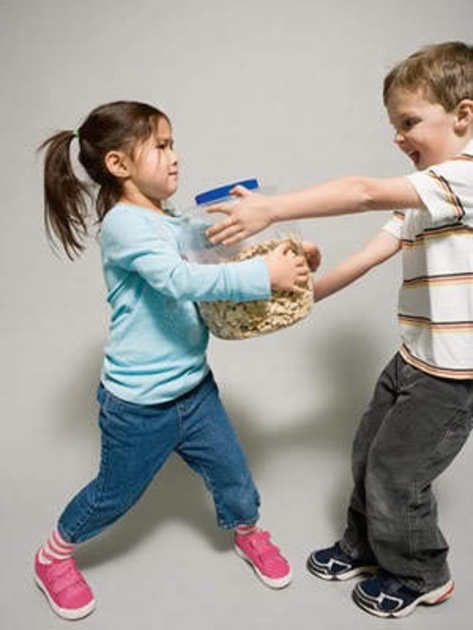
Sibling Conflict: Tips for Prevention and Intervention
"Ma, he's in my room and he’s using my stuff again!"
"It’s her turn to set the table and she wants me to do it!"
"He called me a stupidhead."
Do these statements sound familiar? If you have more than one child, they probably do because these are common examples of sibling conflict. Arguing and bickering among children often cause frustration and concern in parents. However, this behavior is a routine part of growing up in families. Only when bickering turns into constant arguments, fights, and the creation of some potentially dangerous situations, should it be considered a problem that should be addressed by parents. The following are some tips to help parents promote sibling harmony and deal effectively with sibling conflict when it does occur.
Promoting sibling peace and harmony
Allow siblings to express their feelings about each other. "I hate him" or "I wish I had some other sister" are frequent declarations. Don't dismiss or suppress children's resentment or angry feelings. Parents often try to talk children out of their feelings by saying things like "Stop complaining about your brother." But anger is part of being human, and it's certainly normal for siblings to get furious with one another from time to time. Children feel their parents understand them when their upset feelings are acknowledged. This can help them feel better and even treat another child better. Children need to know that although it’s okay to become angry, these feelings do not give them license to behave in cruel and dangerous ways.
Don't make comparisons. It is only natural for parents to notice when one child is more cooperative or better behaved than another, but comparing siblings does not encourage better behavior. Comparison intensifies jealousy and often causes the child who was unfavorably compared to want to get even with the child who was praised. Instead of comparison, each child in the family should be given individual goals and expectations.
Equal distribution. If siblings frequently squabble over the same things, develop a system for equal distribution. For example, a rotation system could be set up in which the children take turns for such privileges as who gets to sit near Totty, who gets to choose where to go to eat lunch, etc.
But—treat children individually—not always equally. Some parents believe that the best way to avoid arguments is to strive for equality among all the children; for example, buying something for one child means buying something for the other children, or complimenting one child means complimenting all the children. However, it’s a mistake to think that this will avoid arguments and sometimes it even encourages comparisons by the children. No matter how hard parents try to make things equal, children are bound to find something that’s unfair. Instead, try to give to each child according to individual need. Rather than tell children that you love them equally, point out the special qualities that make them unique.
When and how to intervene
Don’t become involved in routine bickering or minor fighting. In situations when the fighting is minor and does not appear to be dangerous, try to pretend that you are not aware of what is happening. Whenever possible let siblings work out their own differences. The longer you can stay out of the situation, the sooner they will learn to settle their differences themselves. In addition, trying to figure out who started a fight is nearly impossible, and even if you are sure who started the fight, taking sides only makes things worse. If you cannot ignore the situation, leave the room or ask the children to take their fighting somewhere else. When the children see that you will not get involved, the fighting often settles down quickly.
In the following situations, however, parents are advised to step in during sibling fighting:
- when the amount of fighting seems excessive
- when the same fight happens over and over without any resolution
- when conflict turns into real fighting in which one or both children may be hurt
In conflict situations, the first step is to separate the children until they are calm. After waiting for a cooling down period, listen to each child’s point of view and acknowledge their feelings. Encourage and guide the children to suggest at least one idea about how their conflict could have been avoided or resolved. Even children as young as four of five can suggest useful ideas. In addition, use the opportunity to teach children some basic conflict resolution skills. For example, they can be taught how to use a timer to take turns. Furthermore, parents can teach children social skills by showing them the benefits of asking someone politely rather than grabbing or yelling.
In situations where one child is being teased, parents can provide suggestions on how he/she can handle the situation when it occurs; for example, ignore the teasing, kid back in a way that is humorous, simply agree (in a kidding way) that whatever the teaser is saying is true, tell the teaser that enough is enough, and ask the person in charge (parent, teacher, baby sitter) for help when these other ideas are not working. To make sure that children incorporate these skills, provide practice. Parents can set up and role play some provocative situations (in a playful manner), the child can then role play possible responses and receive feedback about she/he handled the situation.
At times making a family plan can help with a conflict situation. Both consequences and rewards should be used. For example, children might be told that when there is any physical fighting, they will all have a consequence such as a time out, but if they can go for a morning (or entire day) without fighting, everyone will earn a privilege such as an extra snack, a later bedtime or other meaningful privilege.
Obtaining professional help
In a small number of families, sibling conflict is so severe that the help of a mental health professional is necessary. Consider professional consultation if:
- the sibling conflict is so severe that it is leading to marital problems
- there is real danger of physical harm to one or more family members
- the fighting is damaging to the self-esteem or psychological well-being of one or more family members
- the conflict may be related to another psychiatric disorder, such as depression, or to drug abuse
Think long-term
At times, sibling conflict can be very stressful and overwhelming for parents. However, parents should consistently remind themselves that if their efforts to deal with the problem are successful, they will be providing the children with resources that will serve them well later in life. As children watch parents deal with sibling conflict with equanimity and fairness, they are gathering valuable knowledge. They are learning how to get along better with each other, to share, to come face-to-face with jealousy, to jointly solve problems and to accept individual strengths and weaknesses. These experiences prepare them for important relationships in the future with co-workers, spouses, and even their own children.
 Previous
Previous

